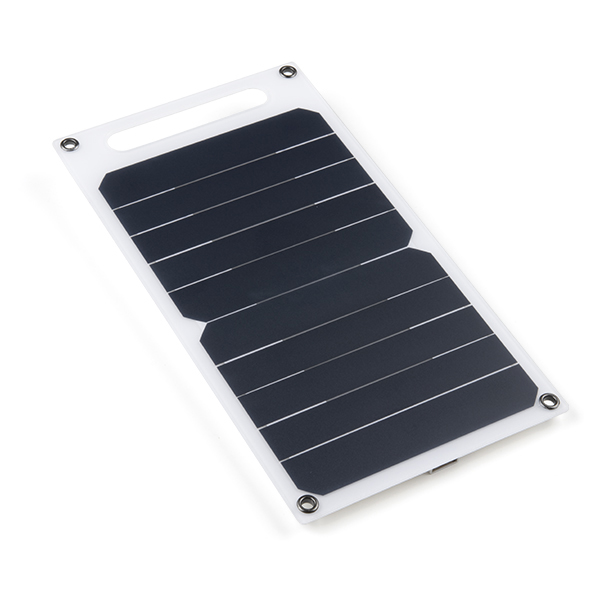Have a project that needs some good power? Do you like free power provided by our friend, Mr. Sun? This solar panel charger is a lightweight, ultra thin (2mm), and affordable power solution. This panel comes with a 5V USB connection port. The panel is capable of 10 watts in the open sun with a peak power output around 6V at 1700mA.
This panel features a monocrystalline silicon material to provide a 20% high photoelectric conversion rate. With a frosted surface makes the panel scratch resistant and more durable. This also has a water resistant epoxy resin seal. The panel is slightly flexible making it considerably lighter than equivalent glass based panels. Because it is light weight this panel is designed for temporary installation on windows (that's what the included suction cups are for) but can be permanently installed. If you're considering permanent installation, note that the DC buck on the back of the panel is not fully waterproof. As long as the panel is mounted with the connector pointed down the panel should survive quite well outdoors.
The panel weighs 3.3648 ounces and measures 259.60mm x 139.69mm x 2.46mm (9.83mm thickness at the USB port).
NOTE: While this product is rated at 10W we found the actual max output to be around 3W (5V at 600mA).
- 1x Solar Charger
- 2x Carbiners
- 4x Suction Feet (useful for mounting to windows)
- Solar Output: 6V, 1700mA
- Output: USB 5V, 1200mA
- Water resistance: IP65
- Material: Monocrystalline Silicon
- Test Output using variable load vs. measure voltage:Load / Measured Voltage
- No Load / 5.15V
- 100mA / 5.12V
- 200mA / 5.09V
- 300mA / 5.06V
- 400mA / 5.03V
- 500mA / 5.00V
- 600mA / 4.94V
- 700mA / 4.91V
- 800mA / 3.13V
- 900mA / 2.72V
- 1000mA / 2.33V
- Dimensions: 259.60mm x 139.69mm x 2.46mm (9.83mm thickness at USB port)
- Weight: 3.3648 ounces.
Solar Panel Charger - 10W Product Help and Resources
Core Skill: Electrical Prototyping
If it requires power, you need to know how much, what all the pins do, and how to hook it up. You may need to reference datasheets, schematics, and know the ins and outs of electronics.
Skill Level: Rookie - You may be required to know a bit more about the component, such as orientation, or how to hook it up, in addition to power requirements. You will need to understand polarized components.
See all skill levels
Comments
Looking for answers to technical questions?
We welcome your comments and suggestions below. However, if you are looking for solutions to technical questions please see our Technical Assistance page.
Customer Reviews
2 out of 5
Based on 1 ratings:
4 of 5 found this helpful:
Panel sucks current with no light
when there is no light on the panel, the regulation module on the back lights up an LED and draws 20mA (note not a calibrated measurement). This makes it useless as it draws almost as much as the project. I am going to look into hacking it to remove this problem (for most devices regulation is redundant).




It warps in direct sunlight. It melts in the car.
I'm thinking of using this to power an ESP32 Thing Plus as well as charge a battery plugged into the Thing Plus. Would you recommend that?
Hi there, it sounds like you are looking for technical assistance. Please use the link in the banner above, to get started with posting a topic in our forums. Our technical support team will do their best to assist you.
That being said, although the power is supplied through a USB connection, if you look at the "tested output" listed in the Features section, it would depend on both the expected load (current draw) of your project and the available sunlight.
Could you post dimensions?
I just received mine. Its 5" wide and 10" long.